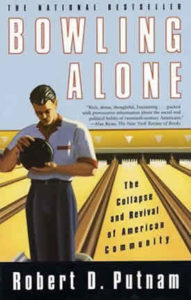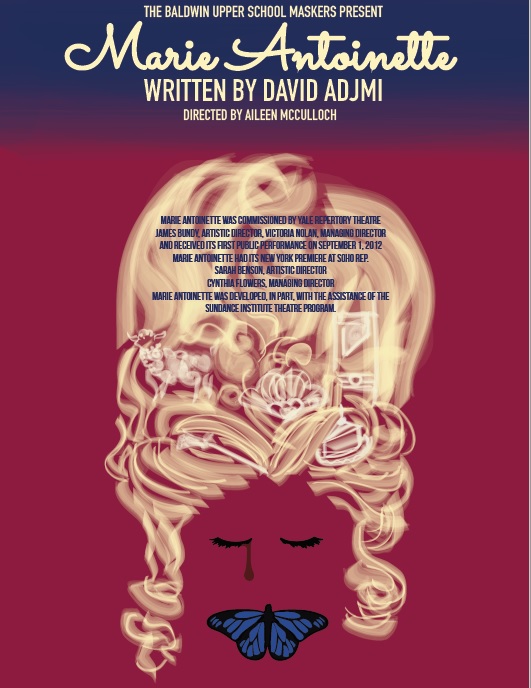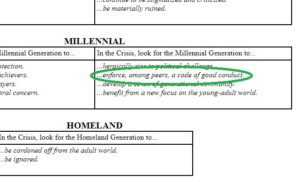 This is the third in a series of reviews of books about the Third Turning which I am finally reading in the Fourth Turning (the first two are here and here). I am “revisiting” Bowling Alone not in the sense that I have read it before, but rather in that I would like to examine its thesis about the decay of civic life in the late twentieth century from the perspective of life nearly two decades into the twenty-first century.
This is the third in a series of reviews of books about the Third Turning which I am finally reading in the Fourth Turning (the first two are here and here). I am “revisiting” Bowling Alone not in the sense that I have read it before, but rather in that I would like to examine its thesis about the decay of civic life in the late twentieth century from the perspective of life nearly two decades into the twenty-first century.
Bowling Alone, by Robert D. Putnam, published in the year 2000, is perhaps one of the best known popular works of sociology. Its basic thesis is that, in the second half of the twentieth century, the United States experienced a rapid decline in community and civic involvement. This thesis is supported by ample data on group participation, social habits and attitudes, all presented in a plethora of graphs and tables. In fact, the book is worth checking out just to see all the data laid out decade by decade, even if you care to interpret it differently.
A key concept in this thesis is that of “social capital,” defined as the value of social networks in providing “generalized reciprocity.” Social capital comes in two forms: “bonding” social capital tightly connects an in-group, whereas “bridging” social capital is a looser connection between people in different groups. There is even a Social Capital Index that the author calculates from a combination of different surveys.
As Putnam sees it, the loss of community in the country and the depletion of social capital is a serious problem. He describes a “fraying civil society” and laments “the erosion of America’s social connectedness and community.” When explaining how group membership rates don’t tell the whole story, because group attendance rates have worsened even more, he writes floridly that “decay has consumed the load-bearing beams of our civic infrastructure.” To uphold this grim description, he presents strong correlations between the Social Capital Index and other measures such as educational attainment, crime rates, and mortality.
In addition to defining social capital, and demonstrating its correlations, Putnam attempts to isolate what factors are associated with its decline at the end of the twentieth century. He does this with multiple regression analysis (explained in the Appendices – this study is very thorough and data driven), and basically concludes that the primary factor is generational change, accounting for half of the decline. Other important factors include television, changing work patterns, and sprawl – in a word, suburbia.
Now personally, as a proponent of Turnings Theory, I believe that generational change tells the whole story. In all of the graphs showing the decline in civic involvement over time, you see the same pattern, as described in the book on page 80: “modest growth in the first third of the [twentieth] century; rapid growth coming out of the Depression and World War II; a high plateau from the 1950s into the 1960s; and a sharp, sustained decline during the last third of the century.”
This pattern exactly tracks the life course of the Greatest Generation, the great civic generation which dominated the twentieth century. The rise and plateau of civic participation in the middle of that century happens in the First Turning era, when the Greatest Generation is in mid-life, the age range that is the peak of any generation’s influence. The decline occurs as that generation ages out of influence, and younger generations with other priorities and values take their place.
By the end of the twentieth century, with civic participation plummeting, to Putnam’s alarm, the United States has reached the Third Turning era. This is an inward-looking, individualist and opportunist social era. The Baby Boomers are now the ones in mid-life (and at the peak of influence) and Generation X is in young adulthood. A shift from a social order based on social capital to one based on financial capital suits both of these generations just fine.
Hence the transformation from a civic society to a market society, and the loss of a sense of stability. The loss of stability worries people, and there is concern over culture and morals even as the economy is booming. In this generational explanation, the factor of the rise of suburbia is a parallel development. The new suburban lifestyle accompanies the emergent generational constellation of cocooning families and prospering Bobos.
In the data presented in the book, there is a glimmer of hope that a turnaround could be forthcoming. In the section on trends in volunteering, an uptick is detected in the age group 25 and younger. That would be a sign that the Millennial generation, who were the teenagers of the 1990s, might be returning to a life of civic engagement.
This data was accumulated and analyzed in the year 2000. So now that 17 years have passed, has anything changed? I am not aware of any studies similar to Putnam’s that have been done since. But the social mood of the United States has grown darker, less confident, suggesting that the curve continues its downward trajectory.
One obvious development of the new era is the rise of social media, which has brought people together, in a sense. If membership in social organizations counted towards the Social Capital Index at the end of the twentieth century, why not membership in Facebook groups at the start of the twenty-first? Bowling Alone poses a similar question when examining the early Internet. However, online connections seem too superficial to qualify as generating social capital. There’s just not much effort involved in liking and sharing memes – the reason for the term slacktivism.
Another characteristic of our time is the partisan divide that splits political opinion into (at least) two distinct camps. This could be seen as an example of bonding social capital developing within groups, but with no bridging social capital to connect them. In fact, the author acknowledges in Bowling Alone that social capital is not necessarily a social good, as it can have the effect of uniting one group against another. For example, the recent protest marches in Charlottesville, Virginia were facilitated by social capital (people on each side of the protest coordinating and travelling together), and then violence ensued.
One interesting observation from Bowling Alone is that, by the end of the twentieth century, evangelical religion had overtaken mainstream religion in popularity. Evangelical religion is concerned with individual piety and proselytization, whereas the mainstream church works for social betterment. This trend is in keeping with the thesis of a decline in civic involvement.
But it also suggests how a new ideology could form in an individualistic age, and then come to drive political change as a new collectivist age approaches. The values that defined piety for the evangelists in the era of civic decline now provide the requirements for political inclusion in the new order. For the Red State these values are conservative religion and aggressive capitalism, and for the Blue State they are the progressive ideals championed by social justice warriors.
As long as the partisan divide remains strong, there won’t be a society-wide return to civic engagement. But once the conflicts are resolved, hopefully with as few Charlottesvilles as possible, it will be back to the First Turning in the social cycle. By then Millennials will be in mid-life, and maybe, through their influence, a sense of community will be restored. Then, if anyone is around to chart the data, those graphs might start going up again.


 This is the third in a series of reviews of books about the Third Turning which I am finally reading in the Fourth Turning (the first two are
This is the third in a series of reviews of books about the Third Turning which I am finally reading in the Fourth Turning (the first two are